
Students will help make a Five Senses and Four Seasons quilt and cinquain poem.
- Subject:
- Science
- Material Type:
- Lesson
- Lesson Plan
- Author:
- Utah Lesson Plans
- Date Added:
- 05/06/2022

Students will help make a Five Senses and Four Seasons quilt and cinquain poem.
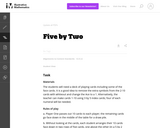
This game will reinforce number before and after as well as reading and sequencing numbers.
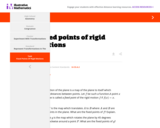
The purpose of this task is to use fixed points at a tool for studying and classifying rigid motions of the plane.
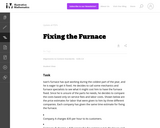
This task can be used to both assess student understanding of systems of linear equations or to promote discussion and student thinking that would allow for a stronger solidification of these concepts.

In this video segment from Cyberchase, the Teleporter breaks and the CyberSquad must try to fix it using clues given to them by Ms. Fileshare.

When you add water to effervescent (fizzy) tablets or baking powder, bubbles are formed: a gas is produced. You can use this gas to inflate a balloon without blowing it up yourself. What kind of gas is it? Let us collect this gas and analyse it through experiments.
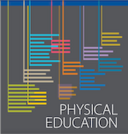
This flag football playbook is designed to help students learn the basic rules of flag football.

Known as both a Southern and a Catholic writer, Flannery O'Connor wrote stories that explore the complexities of these two identities. In this lesson, students will challengethese dichotomieswhile closely reading and analyzing "A Good Man is Hard to Find."

Science Phenomena: 2nd grade - A Changing Earth

This lesson is designed to help students in a yearbook or photography course gain knowlege and improve thier photography skills by putting into practice skills that have been taught previously using photographs taken by others. They will practice camera angles, position and composition techniques. Flat Stanley Visits Epcot, Experience Kissimee, CC 2.0, Flickr

The Big6 is a six-stage model to help anyone solve problems or make decisions by using information. Students can use this model to guide them through the research process. The Super3 is a simplified version of the model for younger students. This worksheet uses the familiar Flat Stanley project to guide students through the Super3.
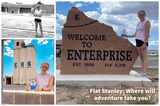
This lesson was created to help elementary-aged students better understand the world around them through the use of Flat Stanley.
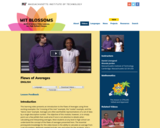
This learning video presents an introduction to the Flaws of Averages using three exciting examples: the ''crossing of the river'' example, the ''cookie'' example, and the ''dance class'' example. Averages are often worthwhile representations of a set of data by a single descriptive number. The objective of this module, however, is to simply point out a few pitfalls that could arise if one is not attentive to details when calculating and interpreting averages. The essential prerequisite knowledge for this video lesson is the ability to calculate an average from a set of numbers. During this video lesson, students will learn about three flaws of averages: (1) The average is not always a good description of the actual situation, (2) The function of the average is not always the same as the average of the function, and (3) The average depends on your perspective. To convey these concepts, the students are presented with the three real world examples mentioned above.

"APERÇU
Construisez une fleur mécanique qui s'ouvre lorsqu'il y a de la lumière. Cette fleur utilise quelques mouvements mécaniques intéressants dont un câble push-pull pour convertir le mouvement de rotation en un mouvement linéaire pour une tige flexible. Ensuite, le mouvement est reconverti en points de pivotement rotatifs pour ouvrir et fermer les pédales. L'utilisation des clips de reliure signifie également que vous êtes libre de créer vos propres pétales de fleurs.
COMPÉTENCES + OBJECTIFS
Construction
Construire le projet en suivant les instructions d'assemblage
Menuiserie
Principes de base de la menuiserie et quincaillerie
Art + Design
Créer et concevoir vos propres pétales de fleurs
Codage"

Balls of varying weights are used to discover the results of force applied to an object.

"Cette construction est utile de deux manières : propulser des objets et tambouriner sur des surfaces. Le concept global vise à augmenter l'inertie du servo en faisant rapidement claquer le collier de serrage pour faire pivoter le bras. La mécanique de cette construction est modelée d'après une pédale utilisée dans une batterie.
L'aspect de propulsion est simplement amusant. Lancez des pièces de monnaie, des boutons et des balles de ping-pong. Lors de l'utilisation de la fonction d'enregistrement d'animation de l'Animate Shield, des rythmes peuvent être enregistrés et bouclés, y compris le réglage de la vitesse.
COMPÉTENCES + OBJECTIFS
Construction
-Construire le projet en suivant les instructions d'assemblage
Musique
-Animer un rythme
Menuiserie
-Principes de base de la menuiserie et quincaillerie
Codage
-Apprendre à utiliser des retards dans le code pour contrôler le timing du mouvement
& Plus !
** Des kits sont disponibles à l'achat sur makestuffmove.com **"

The Flip Book is designed to allow users to type and illustrate tabbed flip books up to ten pages long. Students and teachers can use the flip book for taking notes while reading, making picture books, collecting facts, or creating question and answer booklets.
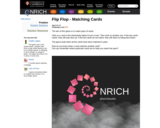
This interactive Flash version of the familiar game Concentration ("pelmanism" in the UK) helps a single user practice addition facts while developing memory and concentration skills. The player can choose an array of 16, 20, or 24 cards, which appear face down. The goal is to flip two cards at a time to match all the 2- or 3-addend expressions with their sums as efficiently as possible. A scoring feature discourages random guessing. Printable versions of the game cards are available to download.

Free professional development training sessions that will help educators make the most of using Flip.
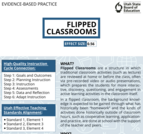
Flipped Classrooms are a structure in which traditional classroom activities (such as lecture) are reviewed at home or before the class, often via pre-recorded video or audio presentations, which prepares the students for more interactive, discovery, questioning, and engagement in active learning activities in the classroom itself. In a flipped classroom, the background knowledge is expected to be gained through what has historically been “homework” and the kinds of activities done historically outside of classroom hours, such as cooperative learning, application-and practice, are done at school with the support of the teacher and peers.